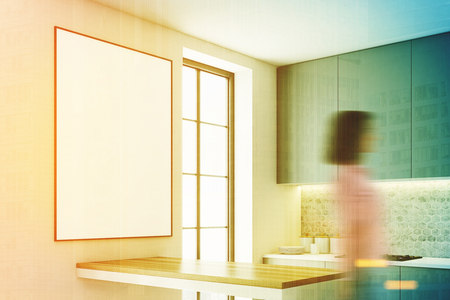Introduction to Mid-Century Design in UK Homes
The charm of mid-century design has found renewed popularity in British homes, particularly within kitchens and bathrooms where both style and function matter deeply. Characterised by clean lines, organic forms, and a balanced use of colour and materials, mid-century aesthetics originated in the post-war era, reflecting optimism and a forward-thinking approach. In the context of UK domestic architecture—often defined by its compact spaces, period features, and subtle elegance—mid-century design offers a unique blend of retro flair and practical living. British homeowners are drawn to this style not only for its nostalgic nod to the past but also for its adaptability to modern lifestyles. The understated yet bold elements of mid-century interiors harmonise well with traditional British layouts, allowing for creative expression without sacrificing practicality. As such, embracing mid-century principles in kitchens and bathrooms provides an opportunity to balance vintage appeal with everyday usability—a synergy that resonates strongly within the contemporary UK household.
Defining Features of Mid-Century Kitchens and Bathrooms
Mid-century design, as it emerged between the 1940s and 1970s, is instantly recognisable for its bold yet functional approach to everyday living spaces. When considering kitchen and bathroom renovations in UK homes, understanding the essential elements of this style—and how theyve been uniquely interpreted on British soil—is crucial for an authentic yet liveable outcome.
Hallmark Colours
Colour palettes from the mid-century era are both nostalgic and surprisingly fresh by today’s standards. Think muted olives, mustard yellows, duck egg blues, and soft pinks—often offset by crisp whites or deep charcoals. In Britain, these hues were sometimes tempered to suit smaller room sizes and the softer natural light typical of many UK homes.
| Original Mid-Century Palette | UK Adaptations |
|---|---|
| Olive green, burnt orange, turquoise | Moss green, slate blue, blush pink |
| Bright yellow, cherry red | Mustard yellow, brick red accents |
| Creamy white, jet black | Off-white, graphite grey |
Materials and Surfaces
The use of materials in mid-century kitchens and bathrooms speaks to a post-war optimism and the drive for efficiency. Laminates, formica worktops, and glossy tiles became popular for their practicality. Wooden cabinetry—particularly teak or light oak—added warmth. In the UK context, you’ll often find terrazzo floors in bathrooms or even quarry tiles in kitchens, a nod to local building traditions that blend seamlessly with mid-century lines.
Common Materials Table
| Material | Application | British Twist |
|---|---|---|
| Laminates/Formica | Worktops, splashbacks | Pale tones to maximise light in compact rooms |
| Ceramic Tiles | Walls & floors (especially bathrooms) | Terrazzo or patterned feature tiles for period authenticity |
| Natural Wood Veneers | Cabinetry & shelving | Teak replaced by locally sourced oak or ash where available |
| Stainless Steel/Chrome Fittings | Taps, handles, trims | Satin finishes preferred over high gloss for understated elegance |
Forms and Layouts: Simplicity Meets Practicality
Simplicity is key in mid-century spaces: flat-fronted cabinets, minimal ornamentation, open shelving for display and storage. The “kitchen triangle” layout—optimising movement between sink, cooker, and fridge—was widely adopted during this era. In British homes, where space is often at a premium compared to their American counterparts, these principles translate into clever built-in storage solutions and multi-functional fittings that make every square foot count.
The upshot? A genuinely practical yet visually distinctive style that can be tailored to British sensibilities without losing any of its retro appeal.
![]()
3. Bringing Retro Elements to UK Kitchens
Integrating mid-century retro elements into a modern British kitchen demands a thoughtful approach that respects both style and practicality. To achieve this balance, start by selecting cabinetry in soft pastel shades or natural wood finishes—a hallmark of the era. Flat-front cabinets with subtle metal handles capture the vintage look without sacrificing ease of use or maintenance. For tiling, consider classic metro tiles or geometric patterns in muted tones, which work well with the typically modest proportions of UK homes and are easy to clean.
When it comes to appliances, seek out models with retro-inspired facades but modern technology under the hood. Brands now offer fridges, ovens, and kettles in period-appropriate hues like duck egg blue or cream, all while meeting today’s energy efficiency standards. Open shelving—another mid-century staple—can be used sparingly to display crockery or cookbooks, adding personality without creating clutter.
To tie everything together, use authentic period accessories: think Bakelite switches, patterned tea towels, and textured glass light fittings. However, always keep workflow and storage at the forefront of your design decisions; retro charm should not come at the expense of daily convenience. With these practical choices, you can enjoy a kitchen that’s as functional as it is evocative of Britain’s mid-century heyday.
4. Mid-Century Bathrooms: Marrying Style with British Practicality
Transforming a UK bathroom with mid-century flair involves more than simply adding retro-inspired tiles or pastel colour palettes. British homes, especially those built in the post-war era, often feature compact bathrooms, so blending vintage aesthetics with everyday functionality is essential. Here are some practical tips for achieving this balance, tailored to the specific needs of UK households:
Choosing Materials: Durability Meets Design
Mid-century bathrooms are renowned for their use of robust materials such as ceramic, terrazzo, and glass. However, it’s important to select finishes that can withstand the high humidity typical of British bathrooms. Consider the following material choices:
| Feature | Mid-Century Inspiration | UK Practicality |
|---|---|---|
| Tiles | Glossy pastel or geometric patterns | Non-slip porcelain or ceramic for safety and easy cleaning |
| Fixtures | Chrome or brushed brass tapware | Water-saving mixer taps compatible with UK plumbing |
| Storage | Floating vanities in teak or walnut veneer | Wall-mounted storage to maximise floor space in smaller rooms |
Optimising Space: A British Necessity
Space efficiency is critical in most UK bathrooms. To introduce mid-century charm without cluttering the room:
- Compact Vanity Units: Opt for slimline vanities with angled wooden legs—an iconic mid-century touch—that also provide under-sink storage.
- Clever Shelving: Use open shelving above the toilet or next to the bath for displaying classic ceramic accessories while keeping essentials at hand.
- Pocket Doors: Where possible, consider installing sliding doors to free up valuable floor area.
The Colour Palette: Subtle Retro Tones for Modern Homes
Avoid overpowering small spaces with bold hues; instead, work with gentle pastels like mint green, powder blue, or blush pink on walls and accessories. These tones reflect light and make bathrooms feel brighter and larger—ideal for often windowless British spaces.
Sustainable Updates: Keeping It Green and Timeless
Sustainability is key in contemporary UK renovations. Choose water-efficient fixtures and LED lighting that echo mid-century shapes but meet today’s energy standards. Upcycling vintage mirrors or cabinets from local markets not only adds authenticity but reduces environmental impact.
Practical Tips Summary Table
| Tip | Description |
|---|---|
| Add Character with Accessories> | Ceramic soap dishes, geometric towels, and patterned shower curtains offer vintage appeal without permanent changes.> |
| Select Easy-Clean Surfaces> | Semi-gloss paint and glazed tiles help prevent mould—a common issue in older UK properties.> |
| Invest in Quality Fixtures> | A well-chosen basin or tap can become a focal point and last for years, fitting both style and function.> |
The secret to a successful mid-century bathroom makeover in a UK home lies in balancing nostalgic details with modern needs—prioritising durability, maximising every inch of space, and choosing features that stand up to daily British life.
5. Material Choices and Sustainable Upgrades
When designing a mid-century kitchen or bathroom for a UK home, selecting materials that are both authentic to the era and environmentally responsible is crucial. Mid-century design is celebrated for its honest use of materials—think wood, glass, ceramics, and metals—so choosing finishes that echo this ethos while meeting modern sustainability standards can be an exciting challenge.
Authenticity in Material Selection
For an unmistakably mid-century look, prioritise natural woods such as oak, teak, or walnut for cabinetry and worktops. These species were staples in British homes during the 1950s and 60s, providing warmth and textural interest. For tiles, opt for glazed ceramic or terrazzo with period-appropriate patterns. Stainless steel remains a practical choice for sinks and taps, reflecting the streamlined efficiency of the era. To enhance authenticity, avoid overly ornate detailing and stick to clean lines and unfussy hardware.
Sustainability: A Modern Necessity
While it’s tempting to source reclaimed materials for their patina and character, ensure they meet today’s safety and efficiency standards—especially in kitchens and bathrooms where moisture resistance is key. FSC-certified wood, recycled glass splashbacks, and low-VOC paints all align with both mid-century values of material honesty and Britain’s current focus on reducing environmental impact. Porcelain tiles made from recycled content offer durability and style without compromising on eco-credentials.
Local Sourcing Matters
Where possible, choose UK-sourced materials to reduce carbon footprint associated with transport. British-made ceramic tiles or locally quarried stone not only support regional craftspeople but also suit the local climate and building traditions. Check for Environmental Product Declarations (EPDs) or similar certifications when purchasing.
Balancing Retro with Practicality
The key is to blend mid-century aesthetics with contemporary performance. Opt for energy-efficient appliances hidden behind period-style cabinetry fronts to maintain the look while benefiting from modern technology. Water-saving taps and dual-flush toilets are essential upgrades that respect both the planet and your household bills. By carefully considering both appearance and sustainability, you can create spaces that honour the past yet are fit for 21st-century living in the UK.
6. Finishing Touches: Fittings, Fixtures, and Accessories
When it comes to perfecting a mid-century kitchen or bathroom in a UK home, the right fittings, fixtures, and accessories are critical for both authenticity and function. The goal is to subtly echo the retro spirit of the 1950s and 60s while ensuring everything remains practical for daily British life.
Choosing Characterful Hardware
Start with cupboard handles and drawer pulls in brushed brass, matte black, or chrome finishes. These finishes not only evoke classic mid-century vibes but are widely available from UK suppliers such as Buster + Punch or Dowsing & Reynolds. For a playful touch, consider geometric shapes—think round knobs or elongated bar handles that nod to atomic-age design.
Sinks and Taps with Retro Flair
For kitchens, Belfast sinks pair surprisingly well with mid-century style when matched with angular taps in copper or stainless steel. In bathrooms, opt for pedestal basins or compact vanities with rounded corners. Mixer taps with crosshead handles deliver both period accuracy and modern ease of use—brands like Burlington and Heritage Bathrooms offer options suited to UK plumbing standards.
Lighting That Makes a Statement
Lighting is an easy way to complete your scheme. Look for pendant lights with opal glass globes or spun metal shades in bold colours like mustard yellow or teal. Wall-mounted sconces with brass arms work beautifully above bathroom mirrors. For kitchens, try cluster pendants over dining nooks or breakfast bars—many UK retailers stock mid-century-inspired designs from the likes of Heal’s or John Lewis.
Accessorising with Authenticity
Accessories bring warmth and personality. Display vintage ceramic canisters on open kitchen shelves or add patterned tea towels for a pop of colour. In bathrooms, introduce geometric-patterned towels or bath mats from British brands such as Habitat. Don’t overlook wall décor—retro-inspired prints or sunburst mirrors create instant impact without overpowering small spaces.
Practical Considerations
In true UK fashion, remember to balance style with everyday practicality. Choose hardwearing materials for high-traffic areas—laminate countertops with wood trim offer durability with a nod to the era’s aesthetic. Select moisture-resistant paints and finishes suitable for the British climate, ensuring your kitchen and bathroom remain easy to maintain as well as stylish.
The finishing touches are what transform your mid-century design from pastiche to practical reality. By sourcing fittings and accessories thoughtfully from the UK market, you can achieve a space that feels both retro-inspired and perfectly suited to contemporary British living.
7. Conclusion: Achieving the Right Balance
When it comes to mid-century kitchen and bathroom design for UK homes, striking the right balance between retro aesthetics and modern-day practicality is key. It’s not simply about recreating a 1950s or 60s look, but about thoughtfully blending nostalgic elements with features that cater to contemporary lifestyles. The unique character of mid-century design—think bold colours, geometric shapes, and honest materials—can bring warmth and charm to any British home. However, day-to-day comfort and efficiency should never be sacrificed in pursuit of style.
For many UK homeowners, practical considerations such as space constraints, storage needs, and energy efficiency are just as important as visual appeal. By choosing high-quality materials and integrating clever storage solutions, you can enjoy the timeless appeal of mid-century design without compromising on usability. Opting for statement tiles or period-inspired fixtures can provide that retro touch, while sleek appliances and modern lighting keep things convenient for busy routines.
Ultimately, a successful mid-century-inspired kitchen or bathroom will feel both inviting and functional—a space where classic style meets everyday ease. With careful planning and a bit of experimentation, you can create rooms that not only look great but also work beautifully for modern UK living. The result is a home that celebrates the best of both worlds: enduring retro charm combined with comfort and practicality for years to come.


